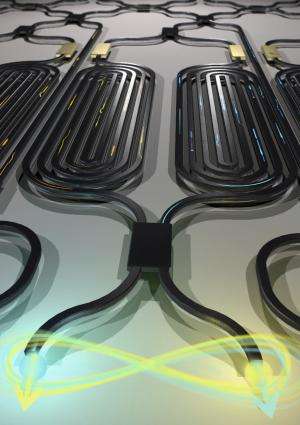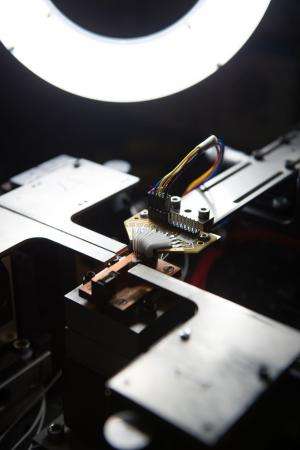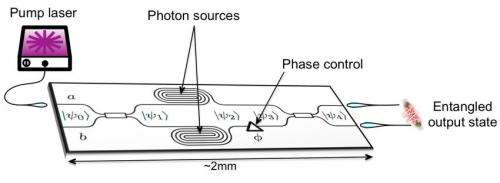Integration brings quantum computer a step closer

An international research group led by the University of Bristol has made an important advance towards a quantum computer by shrinking down key components and integrating them onto a silicon microchip.
Scientists and engineers from an international collaboration led by Dr Mark Thompson from the University of Bristol have, for the first time, generated and manipulated single particles of light (photons) on a silicon chip – a major step forward in the race to build a quantum computer.
Quantum computers and quantum technologies in general are widely anticipated as the next major technology advancement, and are poised to replace conventional information and computing devices in applications ranging from ultra-secure communications and high-precision sensing to immensely powerful computers. While many of the components for a quantum computer already exist, for a quantum computer to be realised, these components need to be integrated onto a single chip.
Featuring today on the front cover of Nature Photonics, this latest advancement is one of the important pieces in the jigsaw needed in order to realise a quantum computer. While previous attempts have required external light sources to generate the photons, this new chip integrates components that can generate photons inside the chip. "We were surprised by how well the integrated sources performed together," admits Joshua Silverstone, lead author of the paper. "They produced high-quality identical photons in a reproducible way, confirming that we could one day manufacture a silicon chip with hundreds of similar sources on it, all working together. This could eventually lead to an optical quantum computer capable of perform enormously complex calculations."

"Single-photon detectors, sources and circuits have all been developed separately in silicon but putting them all together and integrating them on a chip is a huge challenge," explains group leader Mark Thompson. "Our device is the most functionally complex photonic quantum circuit to date, and was fabricated by Toshiba using exactly the same manufacturing techniques used to make conventional electronic devices."
The group, which, includes researchers from Toshiba Corporation (Japan), Stanford University (US), University of Glasgow (UK) and TU Delft (The Netherlands), now plans to integrate the remaining necessary components onto a chip, and show that large-scale quantum devices using photons are possible.
"Our group has been making steady progress towards a functioning quantum computer over the last five years," said Thompson. "We hope to have a photon-based device which can rival modern computing hardware for highly-specialised tasks within the next couple of years."

Much of the work towards this goal will be carried out at Bristol's new Centre for Doctoral Training in Quantum Engineering, which will train a new generation of engineers, scientists and entrepreneurs to harness the power of quantum mechanics using state-of-the-art engineering technique to make real world and useful quantum enhanced devices. This innovative centre bridges the gaps between physics, engineering, mathematics and computer science, working closely with chemists and biologists while interacting strongly with industry.
More information: A full copy of the research paper is available from Nature Photonics DOI: 10.1038/nphoton.2013.339, and a preprint version from arXiv:1304.1490
Journal information: Nature Photonics
Provided by University of Bristol











.jpg)








